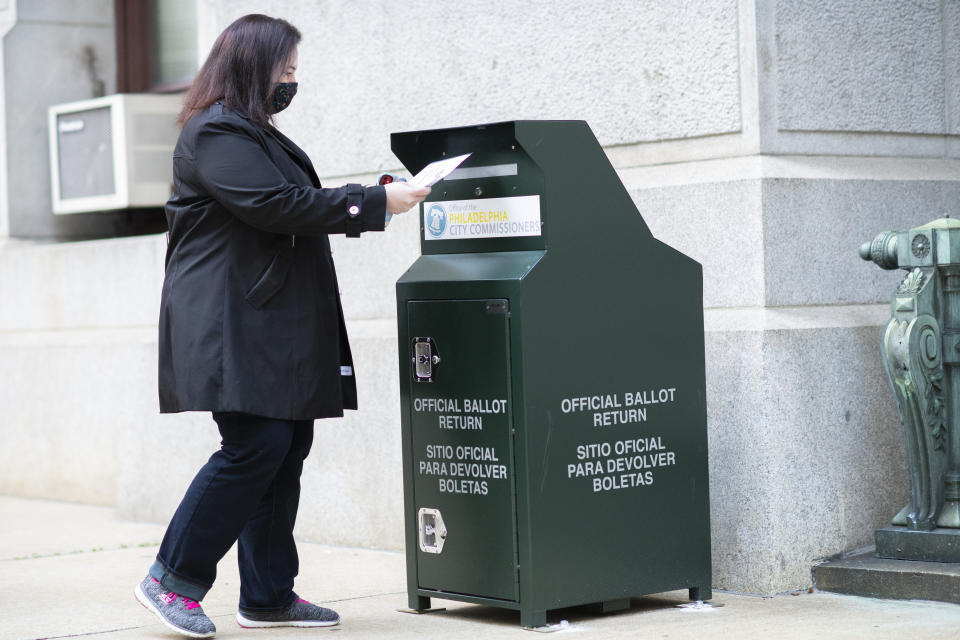Don't freak out over early leads for either Biden or Trump on election night
President Trump and Joe Biden are likely to have early leads on election night in different states based on how those states handle mail and absentee ballots, requiring Americans to take a measured approach to how they interpret results as they come in.
This will be a change of pace, as Americans have gotten used to knowing who won the election at some point during the evening. But the COVID-19 outbreak has changed how we vote, and in many places it will take longer to count all the ballots this time around.
Biden will likely jump to an early lead in a number of states that have finished counting most of their mail and absentee ballots — and early in-person ballots — by Election Day, like Ohio, Florida, North Carolina, Arizona and Texas.

Trump, meanwhile, is likely to have an early lead on election night based on initial returns in three key Rust Belt states — Wisconsin, Michigan and Pennsylvania — whose state laws prevent them from counting mail ballots until Election Day.
Various pundits have used different variations of metaphors to describe this. Trump’s lead in the Rust Belt has been called the “red mirage” that will lead to a “blue shift” as mail ballots are counted. Biden’s early lead in the Southeast and Sun Belt has been called the “blue mirage” and could yield to a “red shift.”
The point is, it will be important for everyone — voters, journalists, pundits, and politicians and their campaigns — not to jump to conclusions based on these early numbers. If one candidate’s early lead is particularly huge, that will still need to be weighed against the votes that have yet to be counted. It will require patience — and an understanding of the underlying electoral math.
For Biden, the votes yet to be counted will be mail and absentee ballots in those Rust Belt states, which will take a few days. For Trump, the votes yet to be counted will be in-person votes in the several other states, which should come in over a few hours on election night.
The only scenario in which an early lead might be indicative of a decisive win for either candidate would be if Biden led in early returns out of the Rust Belt, despite the absence of any mail ballots being counted yet, or if Trump had a significant lead in any of the states that count their mail ballots before Election Day.

The reason for this is that polling has shown a clear partisan breakdown in who was going to vote by mail, versus in person on Election Day. Democrats and Biden supporters told pollsters they would vote by mail, and Republicans and Trump supporters said they wanted to vote in person.
In the three Rust Belt states that decided the 2016 election — Michigan, Wisconsin and Pennsylvania — each state’s Republican legislature refused to allow mail ballots to be opened and processed the way they are in most states: as they arrive, or at least a week before Election Day.
Michigan changed its law to allow for ballots to be opened and processed the day before Election Day, although that still gives clerks very little time to get ballots ready to be counted. Wisconsin and Pennsylvania both did nothing, so mail ballots can’t even begin to be counted until Election Day, when many clerks will be busy actually running the election.
These three states are going to have clerks working in shifts around the clock to try to get all their mail ballots counted, and they have said they hope to be done by Friday, Nov. 6. But if neither Biden nor Trump has 270 Electoral College votes and all three of these states are close, we could be waiting at least several days to find out the winner.
Republicans in Pennsylvania claimed they would not be able to challenge mail ballots for their validity if clerks were given time before the election to open them, but the secretary of state’s office said that was not true.

In Pennsylvania, mail ballots can be counted if they arrive up to three days after Election Day, if they are postmarked by Nov. 3 or if there is no postmark. This is another potential reason for delay, but a far smaller one than the issue of “pre-canvassing,” or preparing the ballots before Election Day. If Republicans allowed pre-canvassing, then most mail ballots would be counted on or shortly after Election Day, and any that came after that would come into play only if the contest were razor-thin.
Trump’s comments this week objecting to votes being counted after Election Day — and falsely claiming that this is illegal — have added to concerns as well that the president may attempt to claim victory well before all votes are counted if he has a lead on election night, even if the number of ballots yet to be counted is far greater than the size of any potential lead at that moment.
_____
Read more from Yahoo News:


